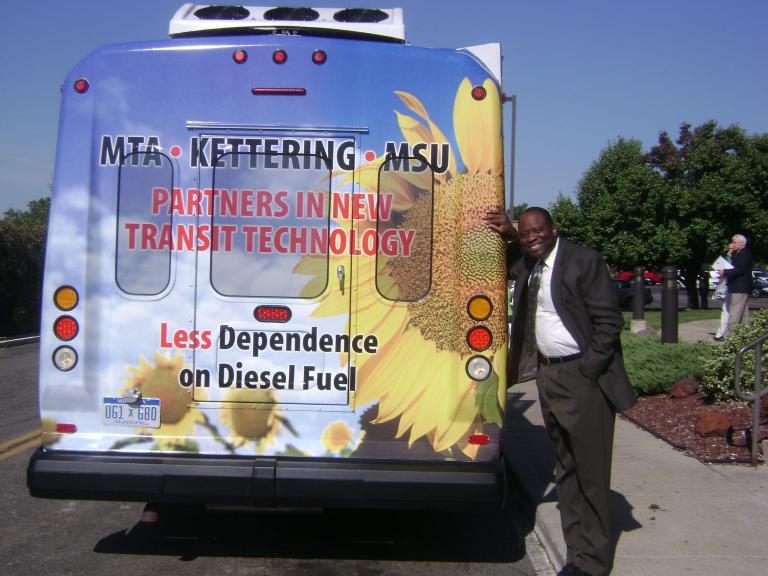
“This partnership is important for Flint, providing national exposure for trying to reduce environmental emissions and to educate the public on fuel cell powered mass transportation.”
Kettering University in Flint has partnered with Flint's Mass Transportation Authority (MTA) to conserve energy through the use of hybrid vehicles. Five flower-power mini buses retro-fitted with hybrid electric/diesel systems are cruising city streets using alternative energy and sporting ecology-themed paint jobs.
The buses represent the first step of what could become a conservation/alternative energy zeitgeist for public transportation in Flint and the state of Michigan.
Once the five mini buses hit the road in early October, Kettering began to collect and analyze data and develop simulation models to understand how to improve the vehicles' efficiency. The data being analyzed includes: road load, speed, braking time, energy flow from the battery to the motor, fuel usage, voltage current and electrical efficiency, according to Dr. Joel Berry, head of Kettering's Mechanical Engineering Department.
Kettering is also working with Michigan State University on the development of more efficient powertrain designs for hybrid buses, a project funded by the 21st Century Jobs Fund. Kettering's Dr. Mohamed El-Sayed, professor of Mechanical Engineering, is the lead faculty in charge of the 21st Century Jobs Fund program between Kettering and Michigan State. He is leading the work with MTA on the design on the hydrogen re-fueling station, to be located in Grand Blanc. He is also leading the development of the Hybrid Vehicle Systems Integration Lab, which is also funded by the 21st Century Job Fund for the development of more efficient powertrain designs for fuel cell buses.
Berry said the mini buses are smaller than traditional full-sized buses. Typically, they are 24-passenger mini buses designed to support handicapped riders. One of the hybrid vehicles has regular seating, the other four have reduced seating and more support for wheelchairs, said Berry of the Flint MTA hybrid fleet.
"These diesel hybrid buses are the first step toward a full-sized vehicle fuel cell bus program in the state of Michigan," he said. But to put in place this type of bus program, the first step is a fuel cell re-fuelling station, according to Berry. His vision is to build the state's first refueling station in Flint.
"Imagine Flint having the first fuel cell bus in the state of Michigan, the first fuel cell fleet in the state of Michigan," said Berry.
The partnership between Kettering and MTA is supporting Kettering's Hybrid Energy Systems (HES) research program and will provide long-term access to MTA hybrid vehicles which will enhance Kettering's hybrid vehicles and fuel cell engineering curriculum.
In return, Kettering will work with MTA to structure training programs to educate their employees and the general public on hybrid vehicle technology, fuel cells and fuel cell bus maintenance, and hydrogen safety. These programs will be coordinated with on-going education and training efforts at the NextEnergy Center, Mott Community College, Baker College, and Lansing Community College.
"This partnership is important for Flint, providing national exposure for trying to reduce environmental emissions and to educate the public on fuel cell powered mass transportation," said Berry.
The project provides a foundation for the eventual developments of a fuel cell-powered bus program in Flint, according to Berry. A fuel cell bus program would provide an opportunity to study the performance of fuel cell buses in a northern climate, which is of interest to the federal Department of Transportation.
Plans are to bring hydrogen fuel cell technologies to MTA buses in the city within three years. To accomplish that, MTA and Kettering are exploring the design and purchase of a hydrogen generation plant. If successful, Flint's MTA could cut its $3.5 million fuel budget each year to $2 million annually, and provide a more environmentally friendly vehicle that doesn't depend on foreign oil producers, Berry said.
Typically, fuel cell buses can be found in Southern California, the East Coast or Europe. Once implemented, evaluations will be made of how humidity, temperature and air quality impact the efficiency of a fuel cell bus.
A fuel cell is an electrochemical energy conversion device. It produces electricity from external supplies of fuel and oxidant. These react in the presence of an electrolyte. Generally, the reactants flow in and reaction products flow out while the electrolyte remains in the cell. Fuel cells can operate virtually continuously as long as the necessary flows are maintained.
Fuel cells differ from batteries in that they consume reactant, which must be replenished, while batteries store electrical energy chemically in a closed system. Additionally, while the electrodes within a battery react and change as a battery is charged or discharged, a fuel cell's electrodes are catalytic and relatively stable. Many combinations of fuel and oxidant are possible, for example, a hydrogen cell uses hydrogen as fuel and oxygen as oxidant.
For more information about Kettering's Center for Fuel Cell Systems & Powertrain Integration program visit http://fuelcells.kettering.edu/index.html
Written by Dawn Hibbard
810-762-9865
dhibbard@kettering.edu